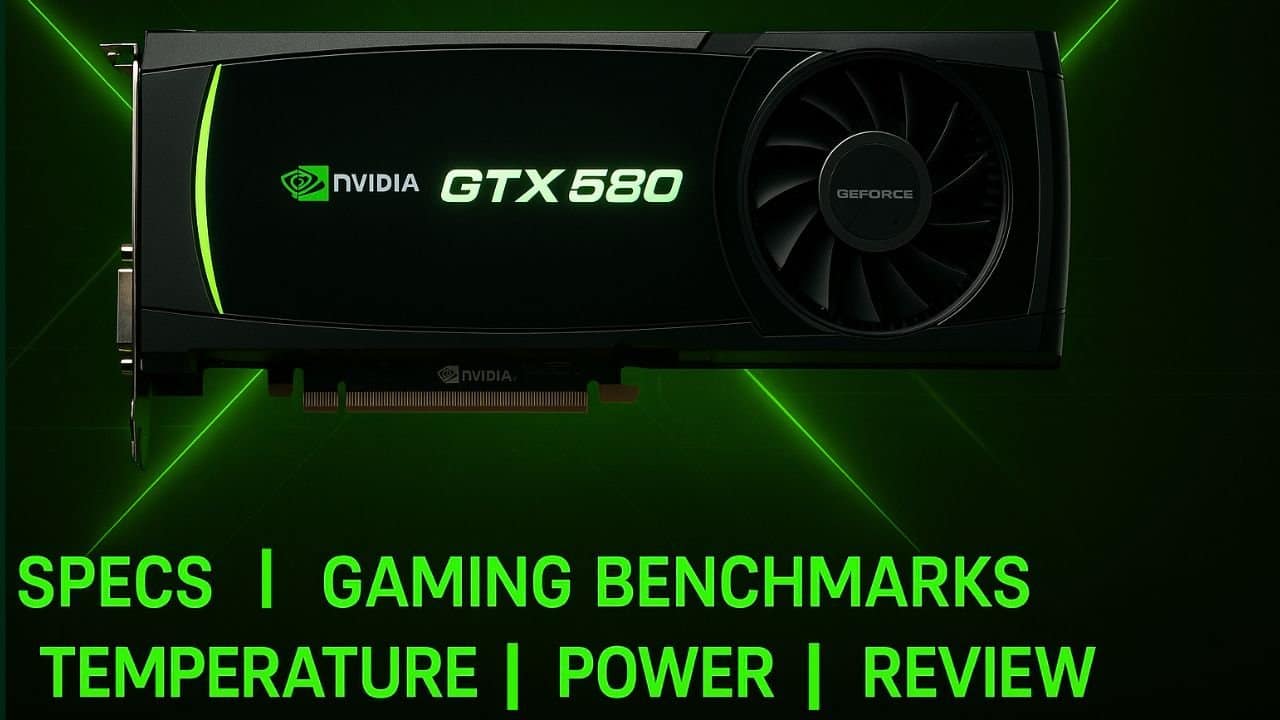Table of Contents
Brief Legacy
Back in 2010, NVIDIA dropped the GTX 580, a powerhouse in the Fermi era. It pushed boundaries then, and even now many people wonder: “Is this old card still usable in 2025?” Let’s find out.
If you’re new to graphics cards, you might want to read our quick guide on what a GPU actually is?
Specifications
Here’s a simple spec table to get the basics out of the way:
| Spec | Value |
|---|---|
| GPU / Architecture | GF110 (Fermi) |
| CUDA Cores / Shaders | 512 cores (full) |
| Base / Boost Clock | 772 MHz |
| Memory | 1536 MB GDDR5 |
| Memory Bus | 384-bit |
| Memory Clock | 2,004 MHz (i.e. 4,008 MHz effective) |
| Memory Bandwidth | 192.4 GB/s |
| TDP / Power Draw | 244 Watts |
| Slot / Interface | Dual-slot, PCIe 2.0 x16 |
| Power Connectors | 1 × 6-pin + 1 × 8-pin |
| Max GPU Temperature | 97 °C |
These numbers are gathered from GPU databases and reviews like TechPowerUp’s GPU database and Notebookcheck.
Want to see how far NVIDIA has come? Check out our RTX 5090 Review to compare specs.
Price & Availability in 2025
When the NVIDIA GeForce GTX 580 launched back in November 2010, it had a premium price tag of around $499 USD a serious investment for gamers and creators at the time. Fast forward to 2025, and the story is quite different. The card is no longer sold new in retail stores and has become a legacy product that mostly appears on second-hand markets and online resale platforms.
Today, you’ll usually find the GTX 580 priced between $20 and $50 USD depending on its condition, brand (like ASUS, MSI, or EVGA), and whether it’s been refurbished. Occasionally, sellers list rare or mint-condition units for around $60–$90+ USD, but those are typically aimed at collectors or nostalgic PC builders. You can browse current listings on marketplaces such as eBay or check deals on AliExpress.
Pro Tip:
Always inspect seller details, photos, and reviews before buying, most GTX 580 cards on the market are over a decade old, so they might require fresh thermal paste, fan maintenance, or even basic cleaning to perform reliably. If your budget allows, also consider slightly newer GPUs like the GTX 760, GTX 960, or GTX 1050 Ti, which offer significantly better performance without costing much more.
Gaming Benchmarks (Estimated)
Here’s how the GTX 580 holds up in games (these are estimates, based on historical benchmark data + modern comparisons).
| Game / Setting | 1080p (Low / Medium) | 1080p (High / Ultra) | 1440p / Others |
|---|---|---|---|
| CS:GO / Valorant / Esports titles | 100–120 fps (low/med) | 70–90 fps | — |
| GTA V | 60–70 fps (med) | 30–40 fps (very high) | 25 fps at 1440p |
| The Witcher 3 | 45–55 fps (medium) | 25–35 fps (high) | 20 fps at 1440p |
| Forza Horizon 4 / 5 | 50 fps (medium) | 25–35 fps (high) | 15–20 fps |
| Cyberpunk 2077 | 25–35 fps (low) | 15–20 fps (med) | nearly unplayable in higher settings |
From aggregated sources, the GTX 580 still scores decently in older/less demanding titles but struggles in newer ones. According to Technical.City’s database, the GTX 580’s “aggregate performance score” puts it far behind modern GPUs.
Also, on UserBenchmark, the GTX 580 has an average benchmark rating at 9.52% relative to a reference performant GPU.
Interpretation
- In older games (2010–2015), the GTX 580 can still manage medium-to-high settings at 1080p smoothly.
- In modern AAA titles (Cyberpunk, etc.), you’ll have to crank settings way down.
- Esports / simpler games are where this card still shines.
Workstation Use
The GTX 580 isn’t built for 2025-level heavy workloads, but it can still handle some lighter tasks. Here’s what to expect:
- For basic video editing (1080p footage, light color grading, simple transitions), the GTX 580 can help accelerate GPU tasks (e.g., in Adobe Premiere, DaVinci Resolve).
- For 3D rendering / GPU workloads (like Blender, Octane, etc.), it’s possible — but very slow compared to modern GPUs.
- Synthetic benchmarks like OctaneBench historically show very low scores for the GTX 580 in rendering tasks. (In older benchmarks, it scored just 67 in OctaneBench.
- For heavier tasks like 4K editing, complex effects, large timelines, it will likely bottleneck.
In Short:
usable for hobby / lightweight editing, not ideal for serious pro workloads in 2025.
Learn more about how GPUs power multimedia work.
Temperature, Power Draw & Efficiency
One of the GTX 580’s recurring criticisms has always been heat and power consumption.
- Typical TDP is 244W.
- Under load, you might see GPU temps climb to 85 – 95 °C, depending on case airflow and cooling.
- The thermal limit is 97 °C pushing near that is dangerous in the long run.
- It’s less power efficient than modern GPUs, its 40nm process is outdated and wasteful compared to newer architectures.
Tips for managing heat / power:
- Use a good case with airflow (intake + exhaust fans).
- Aftermarket cooling helps (better GPU cooler, adding fans).
- Monitor and undervolt (if your GPU tool allows) to reduce wattage and temperature.
- Don’t overclock unless you know what you’re doing.
You can also read our GPU temperature safety guide for deeper insights.
Real-World Usability Tips
Here are some practical pointers if someone plans to use a GTX 580 today:
Driver support and OS compatibility
- Official support is dwindling; newer drivers may not optimally support Fermi cards.
- Use stable older drivers known to work well.
Pair it wisely
- Use a decent CPU (quad-core or better) to avoid bottlenecks.
- Use fast RAM and SSD to reduce other system slowdowns.
Gaming strategy
- Stick to 1080p or lower.
- Drop to medium/low settings in new games.
- Use mods / performance patches if available.
Upgrades
- If you already own it, it’s okay to use it for light / casual gaming.
- If buying, aggressively consider a more modern card (even used from later generations).
Maintenance
- Clean dust off heatsinks / fans regularly.
- Replace thermal paste (if you’re comfortable opening the GPU) to improve cooling.
Pros & Cons
Pros:
- Decent performance in older / casual / esports titles
- Still usable for basic editing and GPU acceleration in lighter tasks
- Nostalgia / value if you already own one
Cons:
- Very limited VRAM (1.5 GB) modern games hit this quickly
- High heat and power draw, inefficient by modern standards
- Weak performance in new, demanding games
- Driver / support limitations in newer OS / software
What We Think…
If you already own a GTX 580, it’s not worthless, you can still squeeze good use out of it in older games, indie titles, or simple GPU tasks. With good cooling and careful settings, it’s serviceable for casual gaming and lightweight editing.
But if you’re considering buying one today as your main GPU, I’d say: only do so if your budget is extremely tight and you understand the limitations. There are many more efficient, better-supported GPUs (even second-hand) that will outclass the GTX 580 in almost every metric.
In Short:
The GTX 580 is a nostalgic relic that can still serve minor use, but it’s no longer a competitive choice in 2025.

